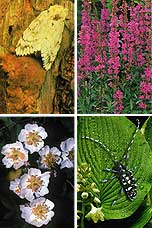Exotic species are not automatically "bad." Most of our important food crops and domesticated animals are exotic. But both exotic and native species (ones that evolved in Maryland) become problems when they are invasive. Invasive species often exhibit certain characteristics: they spread aggressively, reproduce quickly, have short juvenile periods, tolerate a wide range of climatic conditions and habitats, compete efficiently against other species, and thrive in disturbed areas. Unfortunately, the pests and diseases that keep these exotic populations under control in their regions of origin are not present in Maryland. Most of Maryland's invasive species come from somewhere else in the world.
Invasive species cause ecological damage by outcompeting native species, reducing biological diversity, and changing ecosystem functions such as flood and fire regimes or nutrient cycling. The Asian vine kudzu quickly climbs over trees and shrubs and can kill them by strangling and shading. Some invasive species, like the aggressive stinging red imported fire ant, can present serious human health risks. Invasive species also have major economic consequences, ranging from the loss of economically valuable species to the costs of controlling or managing infestations on public lands. Populations of the predominant forest tree in Maryland, the American chestnut, were decimated by the chestnut blight, an exotic fungus accidentally introduced in the 1880s. The state of Maryland spent 1.8 million dollars in 2000 on activities related to exotic invasive species.


